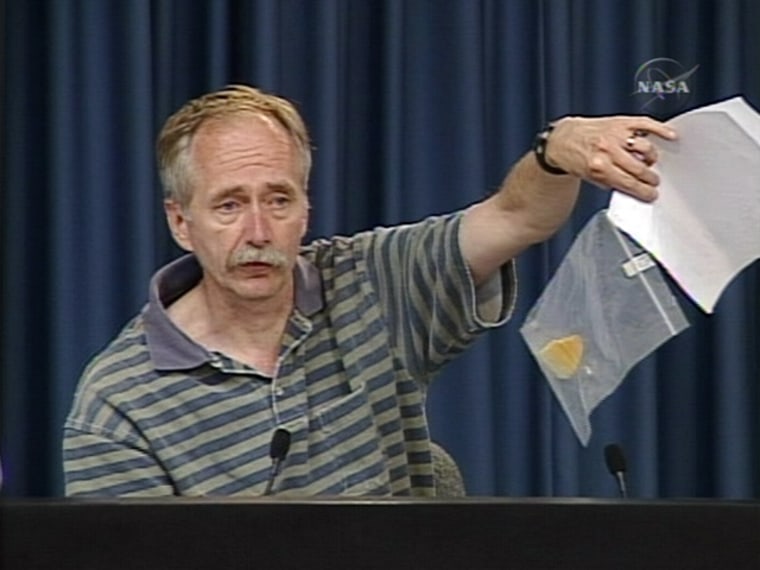CAPE CANAVERAL, Fla. - For the third time, NASA loaded the shuttle Discovery's external tank with rocket fuel — this time in preparation for what could be the space agency's first Fourth of July shuttle launch.
Forecasters provided the best weather outlook yet for Tuesday's scheduled 2:38 p.m. ET liftoff: an 80 percent chance of acceptable conditions for launch, with the main concerns having to do with potential rain showers or thunderstorms near NASA's Kennedy Space Center. Threatening clouds forced NASA to call off the first two launch attempts, on Saturday and Sunday.
Discovery's 12-day mission is aimed at testing safety modifications made since the shuttle's last flight, almost a year ago — including a redesign of the shuttle's external fuel tank to remove a troublesome patch of foam insulation. The shuttle also will resupply the international space station, install new equipment on the station and leave behind German astronaut Thomas Reiter as the station's third crew member.
Although NASA didn't plan it this way, the Fourth of July launch would be a symbolic plus. On a day traditionally given over to fireworks displays, the space agency is planning on a safe and sane ascent powered by almost 4 million pounds (1.8 million kilograms) of rocket fuel, including 1.6 million pounds in the tank and almost 2.4 million pounds in the solid rocket boosters.
"What a great gift NASA could give the nation if we returned the shuttle to operation on Independence Day," John Shannon, chairman of Discovery's management team, said on Sunday. "We're really looking forward to that, and if the weather is good, that's exactly what we'll do."
Another foam questionh
For this third launch attempt, the big question had to do not so much with the weather but with a familiar technical issue: the tank-foam insulation. After Sunday's launch was scrubbed, pad inspectors noticed that the foam insulation around a bracket on Discovery's external fuel tank was cracked. Later, they found that a 3-inch-wide (7.5-centimeter-wide) piece from that cracked area had fallen off.
NASA managers concluded that the crack was created because rainwater entered a tiny crevice in the bracket foam during Sunday's aborted countdown, then froze and widened the crack. When the ice thawed, that weakened the foam enough to cause the break-off.
The foam fragment — which weighed about as much as a penny and looked like a corner of bread crust — sparked additional rounds of inspections and multiple meetings of Discovery's mission management team.
Tank-foam debris has been a concern since the Columbia tragedy in 2003, when a piece of flying foam damaged the wing's leading and eventually led to the loss of the shuttle and its crew. It took two and a half years to redesign the tank and introduce other safety improvements — but foam was once again seen breaking off from the tank when Discovery ascended to orbit last year.
As a result, NASA did another tank redesign — and some engineers within the space agency have said publicly that Discovery's launch should have been held up for still more modifications. Thus, any foam loss, however slight, causes concern.
Managers give go-ahead
Discovery's mission management team mulled over the foam-loss concern during meetings on Monday, and signed off on three issues to clear the tank for launch:
- Engineers determined that the foam loss didn't pose any aerodynamic concerns.
- Projections indicated that the gap in the foam would not lead to excessive ice buildup on the tank, but inspectors were keeping a close watch on that area. If a problem was spotted, the countdown would be stopped, managers said.
- Workers improvised a new inspection device, consisting of a camera mounted on the end of an 8-foot-long (2.4-meter-long) flexible plastic tube, to determine that there were no new areas of concern on the fuel tank.
Bill Gerstenmaier, NASA's associate administrator for space operations, said there was "lots of discussion from many people during the review ... but essentially no dissenting opinions with where we're going." Among those in attendance was NASA Administrator Mike Griffin, he said.
Some observers wondered whether NASA was moving too resolutely toward launch, a phenomenon known as "go fever." Mission managers already have modified their flight rules once by determining that Discovery's crew could work around a bad heater for a maneuvering thruster rather than waiting for a fix.
"If those guys aren't more nervous than I am, they've become jaded and should resign their positions," physicist Doug Osheroff, who served on the Columbia Accident Investigation Board, told The Associated Press.
However, Gerstenmaier said the space agency was setting objective criteria for liftoff, and consistently following those criteria. "I don't think we're taking any additional risk than we did in our original assessment," he said.
